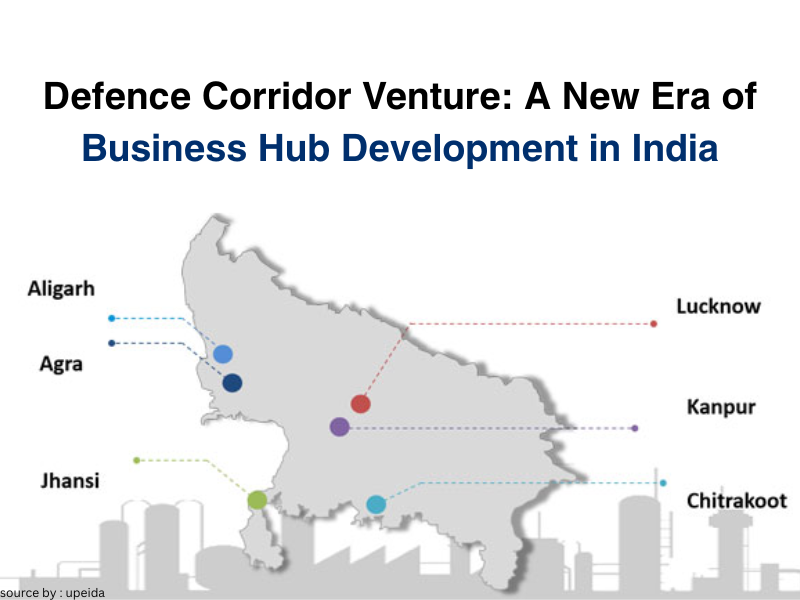India is entering a new phase of industrial and strategic growth through the development of its Defence Industrial Corridors, which are emerging as powerful business hubs. These corridors are not just about strengthening defence capabilities; they are about building a robust, self-sustaining ecosystem that blends innovation, manufacturing, entrepreneurship, and financial growth.
What is a Defence Industrial Corridor?
A Defence Industrial Corridor (DIC) is a specific geographic region designated to facilitate defence manufacturing and related services. The Indian government has launched two major DICs:
- Uttar Pradesh Defence Corridor (UP DIC)
- Tamil Nadu Defence Corridor (TN DIC)
These corridors are strategically planned to attract capital investment, foster collaboration between defence public sector undertakings (DPSUs), private firms, MSMEs, and global defence manufacturers, and to create a globally competitive defence production infrastructure.
Business Opportunities Beyond Defence
While the core focus is on defence manufacturing, the corridors are catalyzing the development of multi-sector business hubs, leading to significant economic spillovers:
- MSME Growth: Small and medium enterprises are being empowered to supply components, electronics, aerospace parts, and more, supported by financial incentives and access to government contracts.
- Startups & R&D: Innovation hubs and incubation centres are being established to support deep tech startups, especially in AI, robotics, cybersecurity, and UAVs, with opportunities for venture capital funding and return on investment (ROI).
- Export-Ready Units: With increasing global interest in Indian defence exports, these corridors provide the infrastructure to become global supply chain contributors through export-oriented units (EOUs).
- Skilled Workforce Development: Collaboration with universities and skill training centres ensures a steady pipeline of technically proficient human capital, minimizing operational costs and maximizing efficiency.
- Dual-Use Technology Development: Encouraging innovations that serve both civilian and military applications, creating diversified revenue streams for enterprises.
Real-World Examples of Engagement
- Bharat Dynamics Limited (BDL) has set up a manufacturing unit in the UP Defence Corridor to produce propulsion systems and other missile components.
- Tata Advanced Systems and Adani Defence & Aerospace have shown interest in establishing facilities in the Tamil Nadu corridor for UAVs, radar systems, and armoured vehicles.
- Rafael Advanced Defense Systems (Israel) is working with Indian partners to manufacture missile systems, leveraging corridor infrastructure.
- Data Patterns and Tonbo Imaging are two defence-tech startups actively contributing to surveillance and electro-optics systems development from Tamil Nadu.
- MSMEs like Aequs Aerospace and Aadyah Aerospace are supplying precision components to global defence OEMs from within the corridor.
Government Support & Financial Incentives
The success of the Defence Corridors is driven by robust government and financial support:
- Policy Incentives: Tax exemptions, subsidized land, capital subsidies, and single-window clearances provide a solid cost-benefit advantage to businesses.
- Public-Private Partnerships (PPPs): Opportunities for joint ventures with Indian and global Original Equipment Manufacturers (OEMs), combining public infrastructure with private investment.
- Ease of Doing Business: Investor-friendly environment supported by state governments and the defence ministry, simplifying capital expenditure (CapEx) planning.
- Foreign Direct Investment (FDI): Liberalized policies encouraging foreign companies to invest and establish operations in the defence manufacturing sector.
Strategic Importance
These corridors align with the government’s Make in India and Atmanirbhar Bharat (self-reliant India) missions. By localizing manufacturing and reducing dependency on imports, India is building strategic autonomy while generating employment, boosting exports, and strengthening its industrial GDP contribution.
Conclusion
The Defence Industrial Corridors are transforming into modern business hubs that go far beyond defence. For MSMEs, startups, global investors, and manufacturing giants, these corridors offer unmatched opportunities for long-term growth. With the added advantage of strong financial incentives and policy support, investing now could yield high ROI and long-term economic value.
As India continues its journey to becoming a global defence manufacturing powerhouse, those who invest and innovate now will be the ones to lead the industries of tomorrow.

